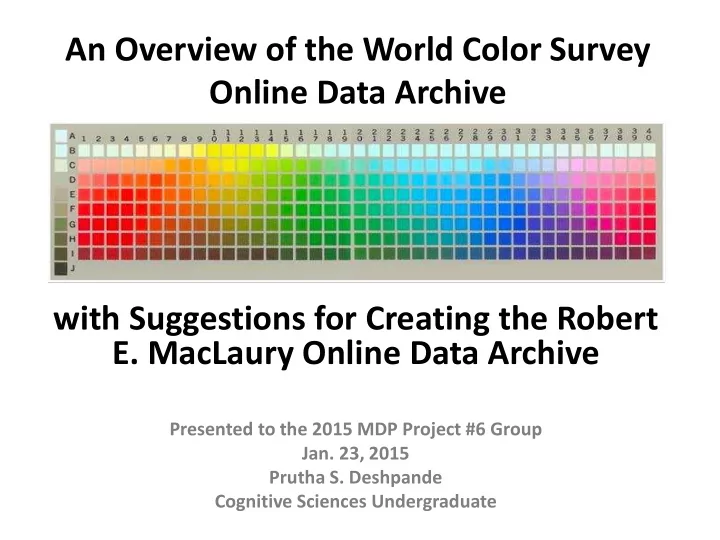

An Overview of the World Color Survey Online Data Archive with Suggestions for Creating the Robert E. MacLaury Online Data Archive Presented to the 2015 MDP Project #6 Group Jan. 23, 2015 Prutha S. Deshpande Cognitive Sciences Undergraduate
RECAP OF WCS TASKS - Relevant to understanding the organization of the archive 1. Naming Task • Informants asked to name 330 colored chips • Always presented in the same random order 2. Focus Mapping Task • Informants asked to select the best example or ‘focus’ of the BASIC color terms, produced in Task 1.
ADDITIONAL MCS TASK - Present in the data we are working with 3. Category Mapping Task • For the same basic color terms as Task 2, informants asked to indicate (place a grain of rice on the color palette) every color that could be named with ‘X’ color term.
8 DATA FILES (all .txt format) - 110 languages, average of 24 informants per language 1. inst – Instructions to fieldworkers 2. chip – Coordinates of stimuli used 3. foci – Chip selected as focus in Task 2 4. foci-exp – Same data as 3 rd file, different format 5. lang – Language information 6. spkr – Informant information 7. term – Abbreviated color terms produced in Task 1 8. dict – Dictionary of all color terms
1. inst.txt – Instructions to fieldworkers Detailed original instruction sheets available as – • Plain text • 8 jpeg images (each opening in a new window)
2. chip.txt – Coordinates of stimuli used None of the text data comes with headers ! Chip Number Row Column Row + Column
3. foci.txt – Chip selected as focus in Task 2 Language Speaker Focus Term Coordinates Number Number Number Abbrv. of focus selection
4. foci-exp.txt – Same data as 3 rd file, different format Language Speaker Focus Term Coordinates Number Number Number Abbrv. of focus selection
5a. lang.txt – Language information - Language number, language name, geographic location, fieldworker name
5b. lang.txt – A nicer table Linked to language information entry on Ethnologue: Languages of the World webpage.
Example entry on Ethnologue
6. spkr.txt – Informant information Language Speaker Age Sex Number Number
7. term.txt – Abbreviated color terms produced in Task 1 Language Speaker Chip Term Number Number Number Abbreviation
8. dict.txt – Dictionary of all color terms Language Term Color Term Number Number Term Abbreviation
Suggestions for Improvement Example database with really nice features 1. Atlas of Pidgin and Creole Language Structures – Data for 76 languages – http://apics-online.info/
1a. Introduction
1b. Much more informative background • Brief overview for those unfamiliar with the field • Linked literature • Description of MCS methods • Instructions to fieldworkers, stimuli used, example coding sheets (Example from Appendix 6)
1c. Appendix 6 – Color and Cognition in Mesoamerica (MacLaury,1997)
2a. Interactive Maps - Dots indicating samples collected in WCS Color Categorization Database: Including data from 116 Mesoamerican languages, plus 32 additional languages world- wide.
2b. Region Maps
3a. Listing languages Search boxes - Complete table downloadable in several formats – csv, xls, rdf, atom.
3b. Appendix 1 – Color and Cognition in Mesoamerica (MacLaury,1997)
4a. Each language listed links to: Ethnologue Information Informant Information Color data
4b. For an overview of each language: • Basic listing of native color terms for each language • Illustrate native color terms with most common ‘best example’ choices • Interactive Munsell palette giving an idea of category boundaries, based on aggregate naming arrays (WCS methodology).
4c. WCS Methodology Link summary table to category map
4d. Focal Points/Category Boundaries Numbers on the Berinmo naming data represent the number of subjects who designated that colour as best example of the category (Davidoff, Davies, Roberson, 1999)
4e. Complete data • Usefully organized in downloadable files - Smaller file downloads - Organized by language/region • Device independent formatting - Several formats • Scanned datasheets
5. Also organized by features, instead of languages Enabling search by interesting language distinctions: - ‘ Grue ’ languages. - Languages with color terms for ‘yellow’. Summary table of each feature
Recommend
More recommend